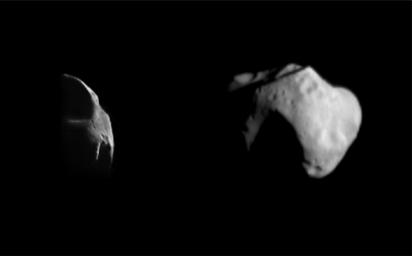
|
Two Views of Mathilde
- Click the image above for a larger view
- Full-Res JPEG (640 x 398) (7.8 kB)
- Full-Res TIFF (640 x 398) (37.4 kB)
Caption:
Two different views of asteroid 253 Mathilde were obtained by the NEAR spacecraft on June 27, 1997. The image at left was obtained as the spacecraft approached Mathilde with its camera pointed near the direction of the Sun; only a few of the prominent ridges on Mathilde are illuminated. The visible area at left is 29 km (18 miles) high, and the phase angle (the angle from Sun-Mathilde spacecraft) is 136°. As the spacecraft receded from Mathilde, it observed the asteroid (about 60 km or 38 miles across) almost fully lit by the Sun at a phase angle of 43° (right image). Mathilde's irregular shape results from a long history of severe collisions with smaller asteroids. The largest visible crater is 30 km (19 miles) in diameter.
Background Info:
Built and managed by The Johns Hopkins University Applied Physics Laboratory, Laurel, Maryland, NEAR was the first spacecraft launched in NASA's Discovery Program of low-cost, small-scale planetary missions. See the NEAR web page at http://near.jhuapl.edu/ for more details.
Cataloging Keywords:
| Name | Value | Additional Values |
|---|---|---|
| Target | 253 Mathilde | |
| System | Main Belt | |
| Target Type | Asteroid | |
| Mission | NEAR Shoemaker | |
| Instrument Host | NEAR Shoemaker | |
| Host Type | Orbiter | |
| Instrument | Multi-Spectral Imager (MSI) | |
| Detector | ||
| Extra Keywords | Collision, Crater, Grayscale | |
| Acquisition Date | ||
| Release Date | 2000-05-07 | |
| Date in Caption | 1997-06-27 | |
| Image Credit | NASA/JPL/JHUAPL | |
| Source | photojournal.jpl.nasa.gov/catalog/PIA02479 | |
| Identifier | PIA02479 | |
